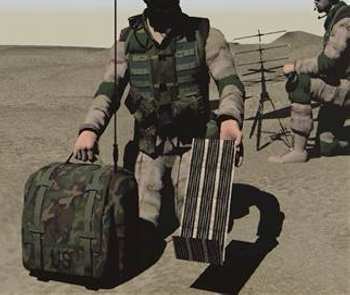
Power consumption at Fort Bliss has dropped by three megawatts, and the post is looking to shed even more in its quest to become a “net zero” energy installation (see video below).
A net-zero energy installation produces as much energy as it consumes. The goal at Bliss, one of the defense department’s fastest growing installations, is in line with the Army’s efforts to develop energy security. These range from Solar field rechargers to better batteries.
“We view energy security as a critical mission-enabler and an operational imperative, which can provide the Army with an essential tactical advantage,” said Jerry Hansen, the Army’s senior energy executive, during a bloggers roundtable discussion, July 7, at the Pentagon. “Our Army installations, our tactical operations, Soldier training — all require secure and uninterrupted access to energy.”
Energy security means the mission can continue without depending on access to the civilian power grid.
In finding new ways to power the mission, leadership at Bliss is setting an example for the Army.
Fort Bliss has begun to implement unique renewable energy opportunities from wind, solar, geothermal and biomass resources to provide secure electric power for the installation.
Hansen said that Fort Bliss has recently found a partner to take four privatized homes on the installation and convert them to solar power, for instance.
“The goal is to take them off the grid totally for a period of (a) year and have them on the solar panels, and let them help record feedback and experience how you can actually power your home quite satisfactorily off solar,” he said. “We’re underway now (in) putting those four homes totally on solar power.”
The general also said that with a grant from the Department of Energy, the city of El Paso and Fort Bliss will be able to work in conjunction to “look at some opportunities to go after geothermal resources that can be shared.”
Additionally, he said, there’s a “great opportunity” to partner with El Paso to look at a combined landfill that could be exploited for biomass power generation. He also said the city is interested in doing an extended lease from the city to develop a solar project.
Hansen said Fort Bliss is currently in the “crawl” stage of moving towards its goal of being a net zero installation.
“We have invested over $50 million of our own money into this. And last year alone, we already got our energy bill down between 10 and 15 percent for the installation,” he said.
The installation is also nearing completion of its microgrid, Hansen said. Additionally, it is installing foam on tents in training areas to reduce the fuel cost to climate control them, has a new headquarters building that will go “off the grid” soon, and is reviewing its vehicle fleets to consider them for conversion to electric.
“I think we’re at the crawl,” he said. “We’re still moving forward with these projects, but as we’re looking out over the next year, we view the continued analysis, I think we’re going to get to the walk phase.”
One Response
These initiatives would of course make perfect sense to the military from a tactical standpoint but even better, initiatives like this bring home the practical advantages of being off -grid and energy self-sufficient to a wider audience. A rising tide floats all boats as they say. Maybe there is hope for us humans to live more sustainably.